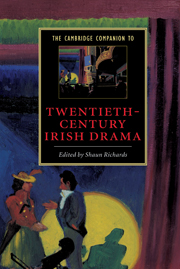Book contents
- Frontmatter
- 1 Plays of (ever) changing Ireland
- 2 Late nineteenth-century Irish theatre: before the Abbey – and beyond
- 3 The ideology of the Abbey Theatre
- 4 The theatre of William Butler Yeats
- 5 Lady Gregory’s Abbey Theatre drama: Ireland real and ideal
- 6 J. M. Synge, ‘national’ drama and the post-Protestant imagination
- 7 On the siting of doors and windows: aesthetics, ideology and Irish stage design
- 8 Oscar Wilde and the politics of style
- 9 George Bernard Shaw and Ireland
- 10 Sean O’Casey’s Dublin Trilogy: disillusionment to delusion
- 11 Ireland’s ‘exiled’ women playwrights: Teresa Deevy and Marina Carr
- 12 Samuel Beckett and the countertradition
- 13 Brian Friel’s sense of place
- 14 The Field Day Theatre Company
- 15 Tom Murphy and the children of loss
- 16 Reconstructing history in the Irish history play
- 17 The Abbey Theatre and the Irish state
- 18 Staging contemporary Ireland
- 19 The Revival revised
- Guide to further reading
- Index
- Series List
7 - On the siting of doors and windows: aesthetics, ideology and Irish stage design
Published online by Cambridge University Press: 28 May 2006
- Frontmatter
- 1 Plays of (ever) changing Ireland
- 2 Late nineteenth-century Irish theatre: before the Abbey – and beyond
- 3 The ideology of the Abbey Theatre
- 4 The theatre of William Butler Yeats
- 5 Lady Gregory’s Abbey Theatre drama: Ireland real and ideal
- 6 J. M. Synge, ‘national’ drama and the post-Protestant imagination
- 7 On the siting of doors and windows: aesthetics, ideology and Irish stage design
- 8 Oscar Wilde and the politics of style
- 9 George Bernard Shaw and Ireland
- 10 Sean O’Casey’s Dublin Trilogy: disillusionment to delusion
- 11 Ireland’s ‘exiled’ women playwrights: Teresa Deevy and Marina Carr
- 12 Samuel Beckett and the countertradition
- 13 Brian Friel’s sense of place
- 14 The Field Day Theatre Company
- 15 Tom Murphy and the children of loss
- 16 Reconstructing history in the Irish history play
- 17 The Abbey Theatre and the Irish state
- 18 Staging contemporary Ireland
- 19 The Revival revised
- Guide to further reading
- Index
- Series List
Summary
It is difficult to determine precisely whether stage design at the Abbey Theatre was a response to ideological imperatives or to financial constraints. Both probably played a significant part. Certainly after the break-up of the Irish Literary Theatre Society at the close of its third season in October 1901 money was scarce. Between 1901 and December 1904 when the Abbey came into being, theatrical activity was focused on W. G. Fay's amateur group, known first in 1902 as the Irish National Dramatic Company but after 1903 as the Irish National Theatre Society. Though there was a wealth of ambition among the members and varying degrees of staging and acting skills, the budget was markedly limited. Design, of necessity, had in practice to be minimal so the accompanying aesthetic focused on minimalism.
By 1903 Annie Horniman had begun to direct some of her small private fortune to assist in the appropriate staging of Yeats’s plays (The King’s Threshold in 1903 and On Baile’s Strand for the opening of the Abbey in 1904). Wanting to have a direct hand in the proceedings, she took over the design of the costumes with very little knowledge of the principles which must govern choice and matching of colours to achieve satisfying stage images. Her work on The King’s Threshold produced a riot of tints, textures and shapes for what is fundamentally an austere morality play.
- Type
- Chapter
- Information
- The Cambridge Companion to Twentieth-Century Irish Drama , pp. 93 - 108Publisher: Cambridge University PressPrint publication year: 2004



